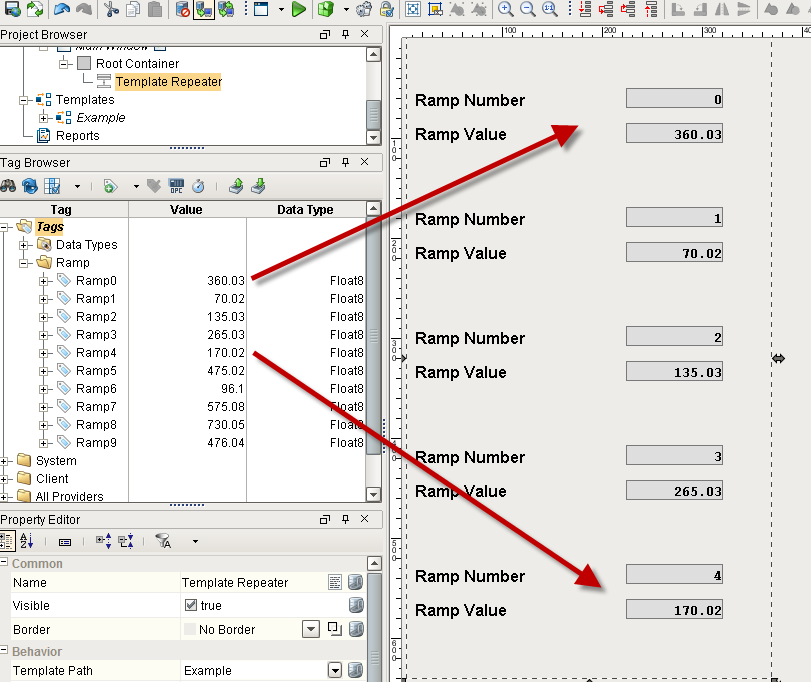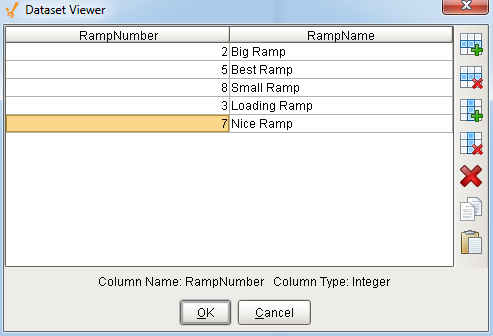Template Repeater Component
Using the Template Repeater
The Template Repeater component lets you easily create multiple instances of a master template for display on the HMI. Each instance shown in the Template Repeater has the same look, feel, and functionality of the master template. The instances can be arranged vertically, horizontally, or in a "flow" layout, which can either be top-to-bottom or left-to-right. If there are too many instances to fit, a scrollbar is added to the display. The Template Repeater also gives you the ability to pass parameters to each instance of the template, making the templates dynamic.
The Template Repeater can create multiple template instances in two different ways, which will also affect how it passes parameters to those instances. The first is Count mode, which will allow you to specify how many times the Template Repeater will repeat a template. It will then use the index number of each template as a parameter that it will pass into the template. The second method is Dataset mode, where each row of a dataset will be a new template instance and each column will be a parameter that will be passed into the template. This is useful if you have multiple parameters that need to be passed into a template. See the Template Repeater page for a more detailed description of this property and how it works. We will go over both methods of using the repeater below.
Creating a Template
Before we use the Template Repeater, we need to first have a template that we need multiple copies of. I will be using the Ramp Tags in the Generic Simulator device built in to Ignition in my template. My template will have a label at the top with the name of the ramp that I come up with, as well as display the ramp number, and the ramp value. To do this our template needs to have two parameters. One called RampNumber, that will get passed the ramp number to be displayed on the template, and for use in an indirect tag binding to get the value. The second parameter will be a RampName, that will be passed in a string name that is the name of the ramp that I made up. The steps for making this template are listed below, or you can skip ahead to the next section if you are familiar enough with making templates.
To Make a Template:
-
In the Templates section of our Project Browser, create a new template. I have named mine Example. See the Templates section for a more detailed description on what templates are and how to use them.
-
We are going to want to pass in a value to the template, so we need to create a Template Parameter.
- Right click on the Root Container, and add a Template Parameter called RampNumber, and make it an Integer type.
- Add a second Template Parameter called RampName, and make it a String type.
-
Next, we want to add some components to our Template.
- We will need two Numeric Labels and one Label. I also added two extra label components, and manually typed in some static text into their Text property. In one, I entered "Ramp Number" and in the other, "Ramp Value".
- Resize the Components so that they are easy enough to read. Place the blank Label component at the top of the Template, and place each Label that we wrote text into next to a Numeric Label.
-
Finally, we want to setup some bindings on our Template.
- Using a property binding, bind the Text property of the blank Label component at the top of the Template to the RampName Template Parameter.
- Using a property binding, bind the Value property of the Numeric Label next to the Label that says "Ramp Number" and bind it to the RampNumber Template Parameter.
- Using an indirect Tag binding, bind the Value property of the Numeric Label next to the Label that says "Ramp Value" and bind it to a Ramp Tag that we have in our Tag browser, using the RampNumber Template Parameter as the indirect reference for the number in the name of the Tag. It should look similar to the image below.

-
Our template is now finished and ready to use. See the image below for an idea of what mine looks like. Your should look similar. Note the two Template Parameters, as well as the placement of the components, including the label at the top that can't be seen because there is no text in it.

Using the Template Repeater with Count Mode
Now let's take a look at how to use the Template we just made in a Template Repeater.
-
On a new window, create a good size Template Repeater that is taller than it is long, which is located in the Containers section of the Component Palette.
-
With the Template Repeater selected, find the Template Path property, and find the name of the template that we just created in the drop down menu.
-
With the Template Repeater still selected, find the Index Parameter Name property. Here we can enter in the name of the property we want to use as an index.
- It should be located in the Behavior section of the Property Editor. If you can't see it, be sure to set the Filter Properties at the top of the Property Editor to 'All'.
- In the Index Parameter Name, we want to enter in 'RampNumber', which was the name of one of our Template Parameters from our Template.
-
Ensure that the Repeat Behavior property of the Template Repeater is set to Count.
-
In the Repeat Count property of the Template Repeater, set the value to '5'.
-
Just like that, you should see your Template repeated 5 times within the Template Repeater. You should notice that our Ramp Number value in the Template corresponds to the index value of the Template, 0 through 4 because it is 0 based. You should also see that the value in our Ramp Value component corresponds to the value of one of our Ramp Tags.

That is all there is to it! You can modify the Repeat Count to change how many times the Template gets repeated.
Using the Template Repeater with Dataset Mode
You may have noticed in our previous example that although we were able to successfully pass in the index parameter into our Template, we were not passing anything into the RampName Template Parameter and because of this, the blank label at the top of our Template remained blank. This is because Count mode only allows a single index parameter to be passed in. However, since we want to pass in two parameters, we can instead use Dataset mode. In addition, because we are going to be defining a dataset to pass in parameters, we don't have to use a 0 indexed parameter, and can instead use whatever values we want. We will use the same Template and Template Repeater from before.
- On the Template Repeater, set the Repeat Behavior to Dataset. All of the Templates that were previously in there should disappear. Don't worry, they will come back!
- Click the Dataset Viewer (
) button on the Template Parameters property of the Template Repeater. You should see a new popup that allows you to build a dataset.
- First we need to add some columns by clicking the Add Column (
) button.
- First, make a column called 'RampNumber'. Make sure the name of the column exactly matches the name of the Template Parameter called RampNumber. It is case sensitive! Make this an integer type.
- Make another column called 'RampName', again making sure the name matches exactly to our RampName Template Parameter. Make this a string type.
- Now lets add some rows by clicking the Add Row (
) button. I have clicked it 5 times to add 5 rows.
- We can add in some values for the RampNumber column.
- Since we are defining all of the values, we don't have to start with a RampNumber of 0. In fact, we don't even need to have them be in sequence! We do need to make sure that it corresponds to one of our ramps though, so enter in a value 0 through 9 for the RampNumber column for each row. I have use 2, 5, 8, 3, 7 in that order.
- Next, we can add some values for the RampName.
- This can be whatever we want, since we are going to be giving unique names to each of our Ramps. Feel free to call your Ramps whatever you like, or you can copy what I have done in the image below.
- We can add in some values for the RampNumber column.
- When finished, the dataset should look something like the image below.

- Click the OK button to save your dataset. Notice how we now have our 5 templates back, and they are using the parameters that we are passing in from the dataset we just created. Notice how the Templates are receiving the parameters in the order that you made them in the dataset. We can also see that each Template instance corresponds to a specific ramp.

Dataset mode is great when you need to pass in multiple parameters, or if you have a single parameter that is not zero based. In addition to manually specifying values like we did in the example, you can instead setup a binding on the Template Parameters property to something like a database table. This allows you to easily modify the templates that are being displayed in the window simply by modifying the database table.
